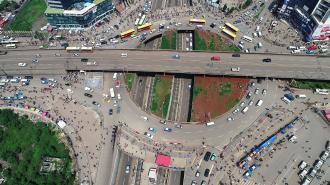Set in the heart of Ethiopia, Addis Ababa — “new flower” — is a city of over 4 million people. Of these, the majority utilize the oldest form of transit, walking, to live their daily lives.
“More than 55% of the transport trips per day in Addis is basically walking,” says Dr. Solomon Kidane Zegeye, the deputy mayor.
With so many of citizens walking for at least a portion of their daily commute, it is imperative that the city provide a safer landscape for non-motorists.
In sub-Saharan Africa — among the fastest urbanizing areas on earth — the micromobility challenge is to change a system that has long focused on cars in places where the average citizen is unlikely to have one.
The Ethiopian capital has spent the last couple of years arranging its policies around this simple fact, putting a premium on pedestrian safety and infrastructure. The city’s transportation plan calls for hundreds of kilometers of bike lanes and pedestrian pathways over the next decade, and for increasing the safety of non-motorists along roadways and intersections.
Micromobility platforms are increasingly hitting the streets in cities around the world. Most obvious are the swarms of electric scooters and armadas of bike sharing services ferrying commuters and tourists to and fro. In the fast-growing cities of the developing world, however, micromobility is often more pedestrian (so to speak), pertaining more to safe infrastructure for the non-motorized transit already in use, notably walking and and in some places bicycling.
Bicycling Gains Popularity as Cultural Stigmas Disappear and Infrastructure Improves
In some countries, gender and cultural barriers hold bicycling back from being a viable alternative. In South Africa, according to a white paper by CB Insights, biking is seen as either for the elites or the poor. The cycling culture is shifting in countries like Kenya and Egypt as the class barriers are beginning to come down, says Chris Kost, the Africa Program Director for the Institute for Transportation & Development Policy (ITDP), a global organization that works with cities to develop environmentally sound and equitable transit systems.
In South Africa, biking has traditionally been seen as either for the elites or the poor. But “now there are a lot more middle-class riders who are taking it up.”
“Now there are a lot more middle-class riders who are taking it up.”
The Rwandan capital of Kigali hopes to soon institute an e-bike sharing program called GURA. According to Kost, Kigali and Addis Ababa are unique among their peer cities in their commitment to building sidewalks and cycle paths along new roads. Both have instituted car-free days, as well. GURA founder and CEO Tony Adesina told The New Times that Kigali’s commitment to cycle infrastructure and fossil fuel reduction are why the homegrown startup has focused its efforts locally.
In Cairo, a project by UN-Habitat showed how quickly improvements in infrastructure can change transit patterns, simply by installing 100 bike racks around the city. There is a great sense of pride in seeing these racks in use, says Salma Mousallem, a program officer at UN-Habitat. They help to connect commuters to Cairo’s metro system and buses, helping plug those with limited transit access into the existing infrastructure. Cairo’s roughly 78 km of metro lines are the city’s backbone, Mousallem says, but the metro’s coverage is unequal: north and south are well served, but the east and west are lacking.
Roads in many African cities are filled with private vehicles and informal public transit — mini-buses, multi-person taxis, and motor scooters — that comprise an ad hoc transit system crucial to the city’s infrastructure. A lack of pedestrian paths and cycling lanes ensure that these vehicles rule the roads, putting walkers at risk and commuters at the mercy of a less efficient system. The large distances between densely populated pockets in Nairobi (in part a legacy of racist colonial planning) make land-use and transportation design extra challenging, Kost says.
A lack of pedestrian paths and cycling lanes ensure that these vehicles rule the roads, putting walkers at risk and commuters at the mercy of a less efficient system.
Addis Ababa Builds for the Future
Addis Ababa commissions a city master plan every 10 years, encompassing all of its various land use developments. The newest plan, released in 2017, calls for development to be focused on transportation corridors. These corridors will also include more pedestrian and bicycle infrastructure. In the past year, Addis Ababa says it has built roughly 26km of new , and more safe pedestrian walkways, with 50km more slated for 2019, Kost says. In the meantime, the existing infrastructure is being optimized and expanded.
By building safe and effective means for people who cannot afford cars to connect to the jobs, services, and social life a city has to offer, cities like Addis Ababa, Cairo, and Kigali are creating a cityscape all of its citizens can use.
Pedestrian walkways already in use in Addis Ababa have been obstructed by informal businesses, says Jirenga Hirpa, director of its Traffic Management Agency. Pedestrians were often forced close to (or even into) motorized traffic. By removing the vendor stalls and restaurant cafe seating, the city widened the walkways already installed. In addition to building new pedestrian paths and bike lanes — which will be required for coming roads — speed limits have been instituted, new traffic signals have been installed, and bollards have been placed to separate walkers from cars.
Enhanced non-motorized infrastructure might reduce the number of vehicles on the road, helping to improve air quality in cities like Cairo. But accessibility is the most crucial aspect of micromobility.
“It’s about equity,” Mousallem says.
By building safe and effective means for people who cannot afford cars to connect to the jobs, services, and social life a city has to offer, cities like Addis Ababa, Cairo, and Kigali are creating a cityscape all of its citizens can use.
